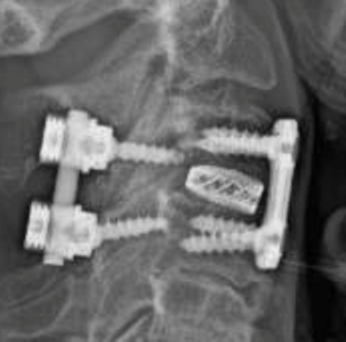Combined 360 degree anterior / posterior fusion cervical spine
Combined 360 degree anterior / posterior fusion cervical spine (PP code V2980)
Patients with a disc prolapse or degenerative ‘wear and tear’ changes in the neck will often have either arm pain (brachalgia) due to nerve root compression or worsening fine hand function (myelopathy) due to spinal cord compression. Depending on the appearance of the scans, the presence of instability and the severity of the symptoms it may be necessary to consider a combined anterior-posterior neck operation to remove the ruptured disc and decompress / stabilise the spinal cord or nerve roots. The results of surgery are generally good. For patients with brachalgia the arm pain will usually improve after surgery. Patients with a myelopathy may see some improvement, but in many cases the aim of surgery is to prevent further deterioration and preserve the remaining function.
The risks of surgery include:
- infection
- bleeding
- spinal fluid leak
- DVT/PE (clots in legs / lungs)
- scar tissue
- reoperation
- recurrent symptoms
- accelerated degeneration
- implant failure
- nerve root injury
- spinal cord injury
- pain, numbness
- weakness, paralysis
- incontinence, impotence
- hoarse voice
- soreness on swallowing
- airway obstruction
- general anaesthetic complications (heart attack, stroke)

The operation is carried out under a general anaesthetic and lasts approximately 180 minutes. It involves making a small incision on the right side of the neck (regardless of the side the patient has symptoms on) and a linear incision down the back of the neck. Once the decompression has been completed and the spinal cord / nerve roots decompressed a spinal fusion is carried out using a fusion block, a plate and cervical screws under x-ray guidance.
The wound is closed usually using a cosmetically sensitive technique with dissolvable stitches so there are no clips to be removed. After the operation the patient will have 2 drains in the wound for 24 hours (these are removed on the ward before discharge). Most patients will go home the next day and will be recovering at home for approximately 6 weeks. Following surgery the patient may notice some neck pain and stiffness but this should settle with simple anti-inflammatory medication such as ibuprofen. Some patients will develop tingling in the arms after surgery due to swelling around the nerves at the site of the operation. This is temporary and will usually settle down after a few days.
Patients do not usually need to wear a neck collar or support. Specialist spinal physiotherapists will advice each patient on a postoperative exercise regime, to encourage neck movements. Further outpatient physiotherapy sessions will be offered, where indicated.
Useful Links


